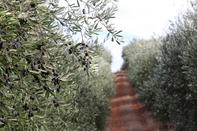The olive oil industry in the country is still very small and can only supply in about a third of South Africa’s requirements, yet we export some product to neighbouring countries.

Olives are hand-harvested and extracted with modern extraction techniques. Many of South Africa’s olive oil producers supply ‘boutique-style’ premium products, mostly of extra-virgin quality.
Varieties of Olives for Oil
While there are hundreds of varieties of olive trees, olive varieties are selected for table olives or making oil depending on their yield, oil content, olive size and taste, time of ripening and other factors.
Olive varietals used for oil in South Africa include Frantoio (747 ha), Coratina (276 ha - plantings increased by 56% from 2012 to 2018) and FS18 whose plantings have also increased by 35% to 231 hectares over the same time period.
Plantings of South Africa’s main variety Frantoio have decreased by 15% while many new cultivars are being planted, albeit a few hectares each.‘New’ olive oil varieties in South Africa - varieties being planted from 2012 onwards - include Picual (78 ha), Arbequina (54 ha) and Koroneiki (52 ha).
Varieties each have a unique flavour profile and chemical properties. Often olive oils from different varieties are mixed to create a specific flavour profile. For example, fruity Arbequina is appreciated for its nutty, buttery, aromatic flavour suggesting apple and artichoke and has low levels of bitterness and spiciness. In contrast, Frantoio is more aromatic, with green overtones and a slightly sweet taste, finishing with bitter and spicy nuances. Other oils are preferred for grassiness and peppery notes; examples are Koroneiki and Manzanillo.
Price of Olive Oil
In South Africa, it is often found that imported extra virgin olive oils are cheaper than South African oils of similar quality. Karien Bezuidenhout, manager of SA Olive, explains that producers in the EU use machine harvesting and receive government help, which subsidises the production of their oils.
In South Africa, olives are hand-harvested, which leads to an increase in the price of production. It is important to note that oils imported from the EU or elsewhere in the Northern hemisphere (where seasons are opposite to those in South Africa) are produced in the ‘previous’ season, while South African olive oils are produced in the current season and are therefore, fresher.
By Marinda Louw